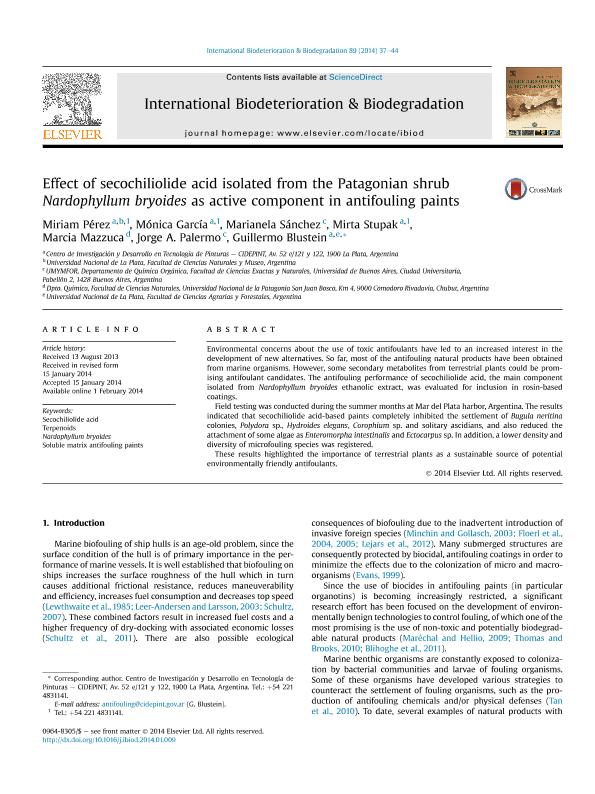Artículo
Effect of secochiliolide acid isolated from the Patagonian shrub Nardophyllum bryoides as active component in antifouling paints
Perez, Miriam Cristina ; García, Mónica; Sánchez, Marianela
; García, Mónica; Sánchez, Marianela ; Stupak, Mirta Elena
; Stupak, Mirta Elena ; Mazzuca, Marcia
; Mazzuca, Marcia ; Palermo, Jorge Alejandro
; Palermo, Jorge Alejandro ; Blustein, Guillermo
; Blustein, Guillermo
 ; García, Mónica; Sánchez, Marianela
; García, Mónica; Sánchez, Marianela ; Stupak, Mirta Elena
; Stupak, Mirta Elena ; Mazzuca, Marcia
; Mazzuca, Marcia ; Palermo, Jorge Alejandro
; Palermo, Jorge Alejandro ; Blustein, Guillermo
; Blustein, Guillermo
Fecha de publicación:
04/2014
Editorial:
Elsevier
Revista:
International Biodeterioration And Biodegradation
ISSN:
0964-8305
Idioma:
Inglés
Tipo de recurso:
Artículo publicado
Clasificación temática:
Resumen
Environmental concerns about the use of toxic antifoulants have led to an increased interest in the development of new alternatives. So far, most of the antifouling natural products have been obtained from marine organisms. However, some secondary metabolites from terrestrial plants could be promising antifoulant candidates. The antifouling performance of secochiliolide acid, the main component isolated from Nardophyllum bryoides ethanolic extract, was evaluated for inclusion in rosin-based coatings. Field testing was conducted during the summer months at Mar del Plata harbor, Argentina. The results indicated that secochiliolide acid-based paints completely inhibited the settlement of Bugula neritina colonies, Polydora sp., Hydroides elegans, Corophium sp. and solitary ascidians, and also reduced the attachment of some algae as Enteromorpha intestinalis and Ectocarpus sp. In addition, a lower density and diversity of microfouling species was registered. These results highlighted the importance of terrestrial plants as a sustainable source of potential environmentally friendly antifoulants.
Archivos asociados
Licencia
Identificadores
Colecciones
Articulos(CIDEPINT)
Articulos de CENTRO DE INV EN TECNOLOGIA DE PINTURAS (I)
Articulos de CENTRO DE INV EN TECNOLOGIA DE PINTURAS (I)
Citación
Perez, Miriam Cristina; García, Mónica; Sánchez, Marianela; Stupak, Mirta Elena; Mazzuca, Marcia; et al.; Effect of secochiliolide acid isolated from the Patagonian shrub Nardophyllum bryoides as active component in antifouling paints; Elsevier; International Biodeterioration And Biodegradation; 89; 4-2014; 37-44
Compartir
Altmétricas



